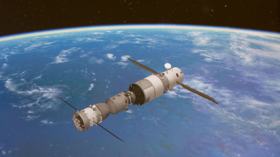2nd Chinese space station falls from sky in FIERY demolition (this time controlled)

China’s space lab Tiangong-2 has descended from orbit and burned up over the South Pacific. Unlike its predecessor, the terminal fall towards Earth was part of a controlled operation by the Chinese space agency.
The 8-ton station re-entered the Earth’s atmosphere on Friday around 21:06 Beijing time (13:06 GMT), Xinhua news agency said, citing China’s Manned Space Agency (CMSA).
It added that a “small amount of debris” that survived the fiery descent fell into a “safe area” in the Pacific Ocean.
China's space lab Tiangong-2 reenters atmosphere under control https://t.co/VFivkdD12Ypic.twitter.com/nbgTmTctdG
— China Xinhua News (@XHNews) July 19, 2019
The 10-meter-long space station was put into orbit in 2016 to test some Chinese orbital technologies, including docking and refueling, with a large future space lab in mind. It was expected to stay in space for about two years, but significantly exceeded its lifespan.
The lab hosted just one manned space mission in 2016 that lasted for about a month. It was technically still fully functional in 2018 when all the experiments had finished and it started to lower its orbit in preparation for the final fall.
Also on rt.com Faulty Chinese space station burns in atmosphere as space-watchers guess its crash siteTiangong-2’s fate was notably different from that of its predecessor, Tiangong-1, which ran out of fuel and crashed down to Earth in an uncontrolled manner in 2018. Contact with the station was lost in 2016, three years after it was abandoned. The possibility of the craft’s remains raining down on populated areas prompted a massive media scare, and 13 space agencies from around the world tracked its descent. The unsettling situation ended with the Chinese station burning up over the South Pacific.
The crashed Tiangong-2 is to be succeeded by a larger modular space lab, which is expected to be one-fifth of the size of the International Space Station (ISS) and will weigh between 80 and 100 tons. Its first module is scheduled to be launched into orbit in 2020.
Think your friends would be interested? Share this story!














